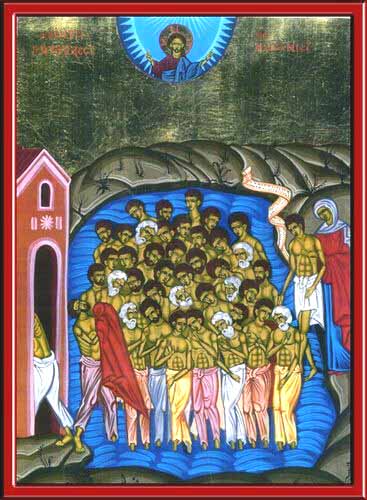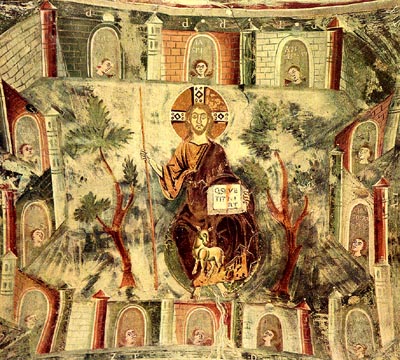 |
The Saint of the Day
The 40 Martyrs of Sebaste, March 10
Prof. Plinio Corrêa de Oliveira
Biographical selection:
The story of these martyrs unfolded in the city of Sebaste during the reign of Emperor Licinius in 320 AD. A garrison of Roman soldiers - 40 in number - were stationed in this remote Armenian town. They were bold, courageous Catholic Roman soldiers who preferred to die rather than renounce their Faith. Upon hearing of this, the infuriated Emperor issued an edict, stating that those throughout the Empire who would not worship pagan gods would be tortured and put to death.
The 40 martyrs of Sebaste in Armenia were whipped, tortured and imprisoned, but would not relent. Finally, the governor Lysias devised an extraordinary kind of death which he hoped would shake their constancy. He ordered the soldiers to be placed in a pond of frozen water and left for a whole winter night.

The 40 martyrs of Sebaste - At right, Melito is encouraged by his mother to follow the exemple of the martyrs; at left, one of them apostatizes, while the sentinel undresses to take his place; at the top, Our Lord opens His arms to receive their souls
|
In the morning the bodies of all were supposed to be carted off to be incinerated. However, the youngest of the officials, whom the acts call Melito, was found alive. Seeing this, the pagan soldiers removed him from the cart with hope that he would apostatize when he came to himself.
The mother of Melito, who was present, understood their intention. Rich in faith, this good Catholic approached her son, quite frozen and barely breathing, looking on her with languishing eyes. She exhorted him to persevere to the end. Then she returned his body to the cart with the corpses of his companions. She told him, “Go, go, my son, proceed to the end of this happy journey with your companions, that you might not be the last of them that present themselves before God.” She pronounced these words without a single tear, and with a joyful countenance she followed the cart to the fire.
After the bodies were burned, the ashes were to be dispersed in the wind and their bones thrown into the river, but God conserved them so that the faithful could gather them later and keep these precious relics.
Reflecting on these martyrs, St. Basil wrote:
“O sacred troop! O glorious company! O invincible battalion! Flowers of the Church, yes I repeat, human flowers! Stars that shine among the stars! Martyrs worthy of the praise of all the centuries! To you the doors of Paradise were opened, and from the palaces of Heaven the Angels, Prophets, Patriarchs and all Saints came out to witness your triumphal arrival. A sight worthy of the Angelic Army! Forty warriors in the very flower of their youth who have disdained this life, who have loved the Lord above parents, children, wives and relatives. They disregarded this temporal life that they might glorify God in their members .…
"Having raised up the trophy of their victory against Hell, each one received a crown from the hand of Christ Jesus Our Lord, to Whom be glory and dominion to the ages of ages.”
Comments of Prof. Plinio:
It is embarrassing to make any comment after having heard the superb eulogy made by St. Basil. But since that is what I am supposed to do, let me consider some of the points of this selection.
You can see the marvelous thing that happened: forty officers arrived in Heaven, as St. Basil observed, as a marching Legion. Indifferent to the barriers that separate the finite and the infinite, the transitory and the eternal, with their armors, helmets, lances and shields, they crossed in cadenced steps through the terrible valley of death and presented themselves on the other side, in Heaven.

St. Basil imagines all the saints of Heaven coming to its gates to witness the arrival of the 40 martyrs of Sebaste
|
St. Basil imagines them arriving at Heaven with every inhabitant coming to see, his model most probably being the triumphal procession into Rome of victorious generals who were acclaimed by the people and crowned with laurels by the Emperor. Such processions used to be the moment of crowning glory for generals. St. Basil continued with this exquisite analogy of the 40 martyred soldiers right up to the crowns bestowed on them by Our Lord. With this, the summit of glory was achieved.
One of their members did not die with the others. The apex of glory for him was yet to come. You heard that the Roman soldiers, moved by a false compassion, wanted to keep him alive so they could again induce him to abjure the Faith. You saw that his mother, in a position more sublime than his own, offered her son for martyrdom. The mother returned him to the cart to be burned, and told him to not lose the opportunity to go to Heaven. Her holocaust has something of a sacerdotal sacrifice. She placed the victim on the cart as if it were an altar. And she followed the cart without shedding a single tear and with a joyful countenance until it reached the site where the bodies were to be burned so that she might see the body of the one to whom she gave life consumed by fire. For she knew that he would receive eternal life as a consequence of the good formation she had given him.
It is almost impossible to imagine a more beautiful thing than this. The only thing one can envision that exceeds this is a similar episode. Another Mother immolating another Son at the Cross. Our Lady also followed Our Lord step by step until His martyrdom reached its end.
You find in this episode a manifestation of a heroism that is even more precious than the heroism of the soldier who offered himself. The mother who offers her son in this way gives proof of a grandeur of soul that is extremely rare in History.
It is also interesting that when St. Basil presented the highest merits of these martyrs, he did not say that they loved God more than the pleasures and seductions of the world. It would have been very beautiful, but it was not what he did. What he said was that they had loved God more than their parents, children and wives, who remained on earth mourning them because they had chosen to die rather than apostatize. Loving God more than their relatives, they fulfilled those words of Our Lord: “Do not think that I am come to send peace upon earth: I came not to send peace, but the sword. For I am come to set a man at variance against his father, and the daughter against her mother …. He who loveth father or mother more than Me is not worthy of Me; and he that loveth son or daughter more than Me, is not worthy of Me.” (Math 10:34-37)
Our Lord said this because at times we have to make such a choice, we have to break with our families to do the will of God. Even if it is very difficult, we should follow the words of Our Lord. This is the reason why St. Basil gave the greatest merit to this point when he eulogized the 40 martyrs of Sebaste. I consider this tribute of St. Basil a truly marvelous thing!
Let us ask the 40 martyrs of Sebaste to teach us to have the same spirit they had, loving God more than anyone else.


The 40 Martyrs & the Baptism of Blood

  | | Prof. Plinio Corrêa de Oliveira | |
The Saint of the Day features highlights from the lives of saints based on comments made by the late Prof. Plinio Corrêa de Oliveira. Following the example of St. John Bosco who used to make similar talks for the boys of his College, each evening it was Prof. Plinio’s custom to make a short commentary on the lives of the next day’s saint in a meeting for youth in order to encourage them in the practice of virtue and love for the Catholic Church. TIA thought that its readers could profit from these valuable commentaries.
The texts of both the biographical data and the comments come from personal notes taken by Atila S. Guimarães from 1964 to 1995. Given the fact that the source is a personal notebook, it is possible that at times the biographic notes transcribed here will not rigorously follow the original text read by Prof. Plinio. The commentaries have also been adapted and translated for TIA’s site.
|
Saint of the Day | Home | Books | CDs | Search | Contact Us | Donate

© 2002- Tradition in Action, Inc. All Rights Reserved
|
 |

|